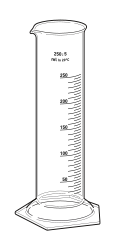Graduated cylinder
· Measuring cylinder 250 ml, with "In" marking
· 
High form
· 
Low form
A graduated cylinder is a vertical, hollow cylinder with a spout and base, which is provided with a scale (bore) for measuring volumes. Measuring cylinders are also used to determine bulk density. They are available in high or low form. The corresponding standard is DIN EN ISO 4788 Laboratory glassware - Graduated cylinders and mixing cylinders.
In the laboratory, measuring cylinders made of glass are mostly used; however, they can also be made of plastic. There are also graduated cylinders that are made of glass with the exception of the plastic base.
Stand cylinders have the same shape as graduated cylinders, but no scale.
The point at which a graduated cylinder is read has a curved surface (meniscus) due to the hydrophilic interaction of water with glass. The scale of the measuring cylinder only shows the correct volume if the lowest point of the meniscus sits parallax-free on the upper edge of the scale line. When reading, the eye should always be at the height of the scale line to be read. An imprint "In" indicates that the measuring cylinder has been "adjusted to sprue". This means that the measured volume is in the vessel and the amount of liquid taken up corresponds to the volume printed on the cylinder. When emptying into another container, a residual quantity always sticks to the wall of the measuring cylinder. Measuring cylinders are often incorrectly used as "Ex" volumetric instruments, although they have not been "adjusted to drain".

Mixing cylinder with ground joint (without ground joint plug)
Mixing cylinder
A mixing cylinder is a measuring cylinder which is provided with a standard ground joint (NS) instead of a spout, is closed with a ground joint stopper and can thus be used for mixing measured liquids.
Search within the encyclopedia